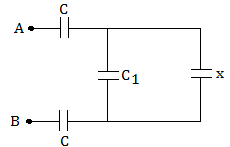12th Grade > Physics
ELECTRIC CHARGES FIELDS AND GAUSS LAW MCQs
Total Questions : 30
| Page 3 of 3 pages
Answer: Option C. -> Radial, inward
:
D
The force is perpendicular to the displacement.
:
D
The force is perpendicular to the displacement.
Answer: Option C. -> Radial, inward
:
C
Option (a) shows lines of force starting from one positive charge and terminating at another. Option (b) has one line of force making closed loop. Option (d) shows all lines making closed loops. All these are not correct. Only option (c) is correct.
:
C
Option (a) shows lines of force starting from one positive charge and terminating at another. Option (b) has one line of force making closed loop. Option (d) shows all lines making closed loops. All these are not correct. Only option (c) is correct.
Answer: Option D. -> (σ1−σ2)2ϵ0
:
D
E=E1−E2
=σ12ϵ0−σ22ϵ0
E=σ1−σ22ϵ0
:
D
E=E1−E2
=σ12ϵ0−σ22ϵ0
E=σ1−σ22ϵ0
Question 25. A cube is arranged such that its length, breadth and height are along X, Y and Z directions. One of its corners is situated at the origin. Length of each side of the cube is 25 cm. The components of electric field are Ex=400 √2N/C,Ey=0 and Ez=0 respectively. Find the flux coming out of the cube at one end.
Answer: Option C. -> 25√2
:
C
Φx=ExAcos(0)
=400√2×14×14
=400√216=25√2
:
C
Φx=ExAcos(0)
=400√2×14×14
=400√216=25√2
Answer: Option C. -> 25√2
:
C
This is the charge of an electron. It is the minimum charge possible. All other charges are its integral multiple.
:
C
This is the charge of an electron. It is the minimum charge possible. All other charges are its integral multiple.
Answer: Option A. -> Zero
:
A
All charge resides on the outer surface so that according to Gauss law, electric field inside a shell is zero.
:
A
All charge resides on the outer surface so that according to Gauss law, electric field inside a shell is zero.
Answer: Option B. -> 260 newton / coulomb
:
B
For balance mg=eE⇒E=mge
Also m=43πr3d=43×227×(10−7)3×1000kg
⇒E=4/3×22/7×(10−7)3×1000×101.6×10−19=260N/C
:
B
For balance mg=eE⇒E=mge
Also m=43πr3d=43×227×(10−7)3×1000kg
⇒E=4/3×22/7×(10−7)3×1000×101.6×10−19=260N/C
Answer: Option E. -> If assertion is false but reason is true.
:
E
If electric lines of forces cross each other, then the electric field at the point of intersection will have two direction simultaneously which is not possible physically.
:
E
If electric lines of forces cross each other, then the electric field at the point of intersection will have two direction simultaneously which is not possible physically.


















